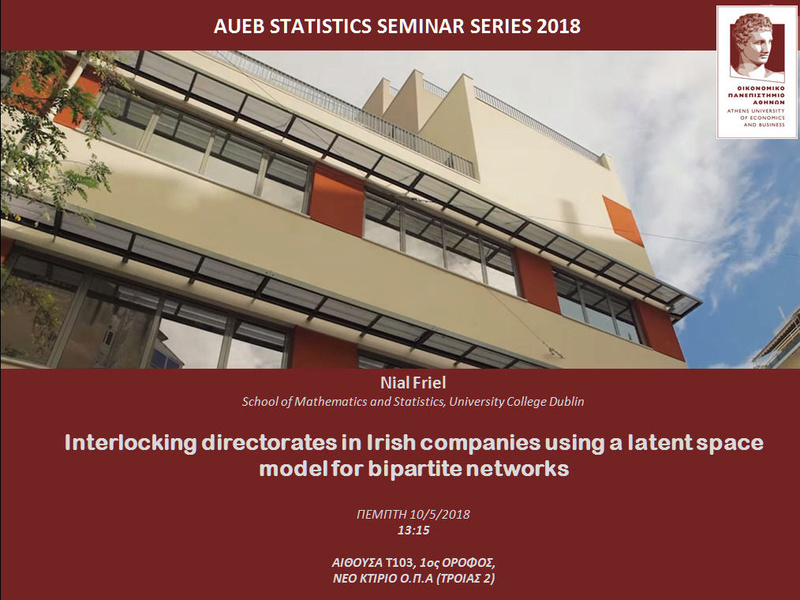 AUEB STATS SEMINARS 10/5/2018: Interlocking directorates in Irish companies using a latent space model for bipartite networks by Prof. Nial Friel
AUEB STATS SEMINARS 10/5/2018: Interlocking directorates in Irish companies using a latent space model for bipartite networks by Prof. Nial Friel
Wed 25 Apr 2018 - 16:45
ΚΥΚΛΟΣ ΣΕΜΙΝΑΡΙΩΝ ΣΤΑΤΙΣΤΙΚΗΣ ΜΑΪΟΣ 2018

Nial Friel
School of Mathematics and Statistics,
University College Dublin
Interlocking directorates in Irish companies using a latent space model for bipartite networks
ΠΕΜΠΤΗ 10/5/2018
13:15
ΑΙΘΟΥΣΑ Τ103, 1ος ΟΡΟΦΟΣ,
ΝΕΟ ΚΤΙΡΙΟ ΟΠΑ (ΤΡΟΙΑΣ 2)
ΠΕΡΙΛΗΨΗ
We analyze the temporal bipartite network of the leading Irish companies and their directors from 2003 to 2013, encompassing the end of the Celtic Tiger boom and the ensuing financial crisis in 2008. We focus on the evolution of company interlocks, whereby a company director simultaneously sits on two or more boards. We develop a statistical model for this dataset by embedding the positions of companies and directors in a latent space. The temporal evolution of the network is modeled through three levels of Markovian dependence: one on the model parameters, one on the companies’ latent positions, and one on the edges themselves. The model is estimated using Bayesian inference. Our analysis reveals that the level of interlocking, as measured by a contraction of the latent space, increased before and during the crisis, reaching a peak in 2009, and has generally stabilized since then.
Facebook event: https://www.facebook.com/events/1999321920286692/

Nial Friel
School of Mathematics and Statistics,
University College Dublin
Interlocking directorates in Irish companies using a latent space model for bipartite networks
ΠΕΜΠΤΗ 10/5/2018
13:15
ΑΙΘΟΥΣΑ Τ103, 1ος ΟΡΟΦΟΣ,
ΝΕΟ ΚΤΙΡΙΟ ΟΠΑ (ΤΡΟΙΑΣ 2)
ΠΕΡΙΛΗΨΗ
We analyze the temporal bipartite network of the leading Irish companies and their directors from 2003 to 2013, encompassing the end of the Celtic Tiger boom and the ensuing financial crisis in 2008. We focus on the evolution of company interlocks, whereby a company director simultaneously sits on two or more boards. We develop a statistical model for this dataset by embedding the positions of companies and directors in a latent space. The temporal evolution of the network is modeled through three levels of Markovian dependence: one on the model parameters, one on the companies’ latent positions, and one on the edges themselves. The model is estimated using Bayesian inference. Our analysis reveals that the level of interlocking, as measured by a contraction of the latent space, increased before and during the crisis, reaching a peak in 2009, and has generally stabilized since then.
Facebook event: https://www.facebook.com/events/1999321920286692/
- AUEB STATS SEMINARS 2/11/2017: Latent Space Stochastic Block Model for Social Networks by Brendan Murphy (UCD)
- AUEB Stats Seminars 11/2/2022: "Assessing competitive balance in the English First Division/Premier League for over forty seasons using a stochastic block model" by Nial Friel (University College Dublin)
- AUEB STATS SEMINARS 30/3/2018: Estimating metabolite networks using a multi-step network approach that integrates information from lower leveled omic graphical structures by Georgios Bartzis
- AUEB STATS SEMINARS 16/10/2018: Phase II trials in oncology – is Simon’s optimal design the optimum? by Prof. Meinhard Kieser
- AUEB STATS SEMINARS 3/10/2018: A dynamic binomial model with application to the propensity to use tax amnesty by Jonas Andersson
Permissions in this forum:
You cannot reply to topics in this forum

 Grstats
Grstats
